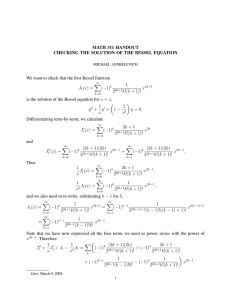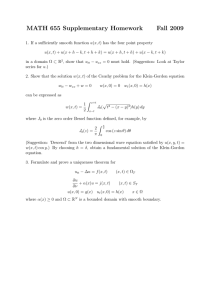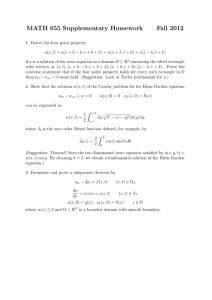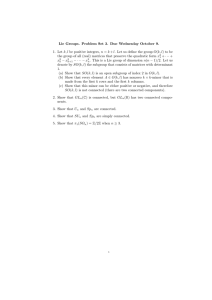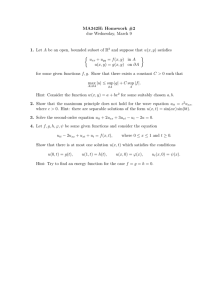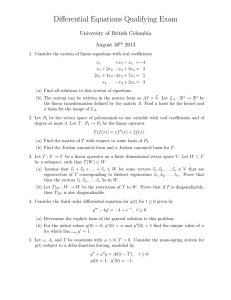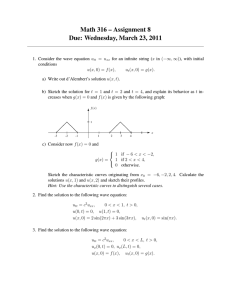Bessel’s equation
advertisement
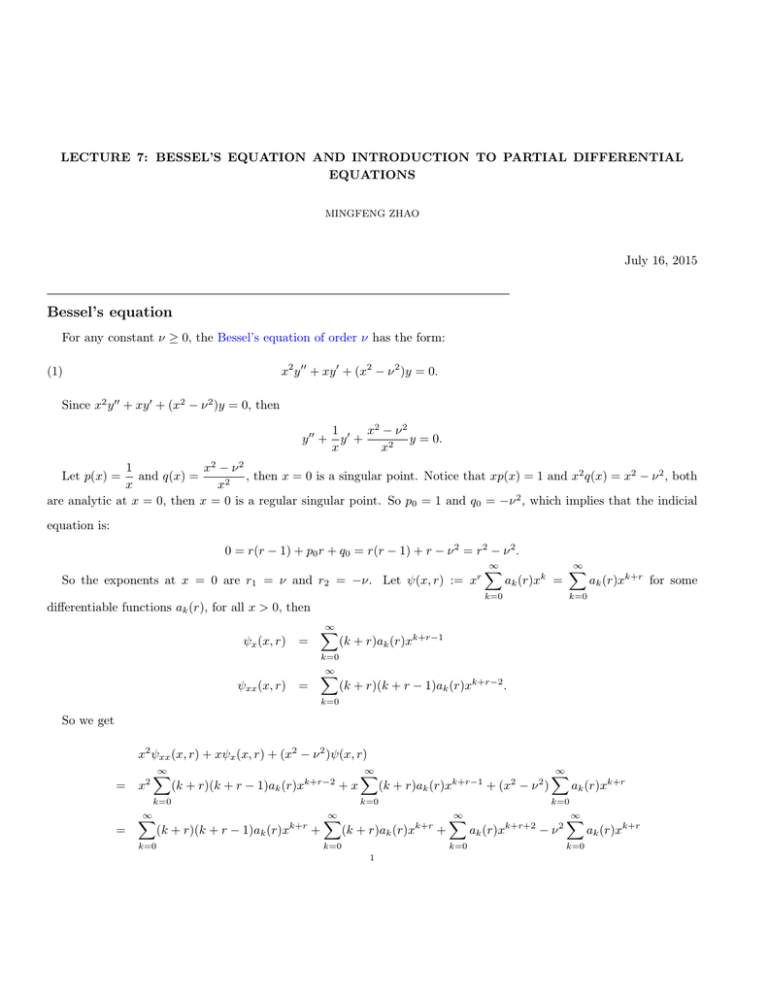
LECTURE 7: BESSEL’S EQUATION AND INTRODUCTION TO PARTIAL DIFFERENTIAL
EQUATIONS
MINGFENG ZHAO
July 16, 2015
Bessel’s equation
For any constant ν ≥ 0, the Bessel’s equation of order ν has the form:
x2 y 00 + xy 0 + (x2 − ν 2 )y = 0.
(1)
Since x2 y 00 + xy 0 + (x2 − ν 2 )y = 0, then
y 00 +
1 0 x2 − ν 2
y +
y = 0.
x
x2
x2 − ν 2
1
and q(x) =
, then x = 0 is a singular point. Notice that xp(x) = 1 and x2 q(x) = x2 − ν 2 , both
x
x2
are analytic at x = 0, then x = 0 is a regular singular point. So p0 = 1 and q0 = −ν 2 , which implies that the indicial
Let p(x) =
equation is:
0 = r(r − 1) + p0 r + q0 = r(r − 1) + r − ν 2 = r2 − ν 2 .
∞
∞
X
X
So the exponents at x = 0 are r1 = ν and r2 = −ν. Let ψ(x, r) := xr
ak (r)xk =
ak (r)xk+r for some
k=0
k=0
differentiable functions ak (r), for all x > 0, then
ψx (x, r)
=
∞
X
(k + r)ak (r)xk+r−1
k=0
ψxx (x, r)
=
∞
X
(k + r)(k + r − 1)ak (r)xk+r−2 .
k=0
So we get
x2 ψxx (x, r) + xψx (x, r) + (x2 − ν 2 )ψ(x, r)
= x2
∞
X
(k + r)(k + r − 1)ak (r)xk+r−2 + x
k=0
=
∞
X
(k + r)(k + r − 1)ak (r)xk+r +
k=0
∞
X
(k + r)ak (r)xk+r−1 + (x2 − ν 2 )
k=0
∞
X
(k + r)ak (r)xk+r +
k=0
ak (r)xk+r
k=0
∞
X
k=0
1
∞
X
ak (r)xk+r+2 − ν 2
∞
X
k=0
ak (r)xk+r
2
MINGFENG ZHAO
=
∞
X
∞
X
[(k + r)(k + r − 1) + k + r − ν 2 ]ak (r)xk+r +
k=0
=
∞
X
k=0
[(k + r)2 − ν 2 ]ak (r)xk+r +
k=0
=
ak (r)xk+r+2
∞
X
ak−2 (r)xk+r
k=2
(r2 − ν 2 )a0 (r)xr + [(1 + r)2 − ν 2 ]a1 (r)x1+r +
∞
X
{[(k + r)2 − ν 2 ]ak (r) + ak−2 (r)}xk+r .
k=2
Let a1 (r) = 0, define the sequence {ak (r)}∞
k=1 by the recurrence relation:
[(k + r)2 − ν 2 ]ak (r) + ak−2 (r) = 0,
for all k ≥ 2.
That is,
ak (r) =
−1
· ak−2 (r),
(k + r)2 − ν 2
for all k ≥ 1.
Then
a2k+1 (r) = 0,
and a2k (r) = (−1)k a0 (r)
k
Y
1
,
2 − ν2
(2i
+
r)
i=1
for all k ≥ 0.
So we get
(2)
ψ(x, r) = x
r
∞
X
a2k (r)x
2k
r
= a0 (r)x + a0 (r)x
r
k=0
(3)
2
2
∞
X
k
(−1)
k=1
2
x ψxx (x, r) + xψx (x, r) + (x − ν )ψ(x, r)
=
2
2
k
Y
1
2 − ν2
(2i
+
r)
i=1
!
x2k
r
(r − ν )a0 (r)x .
For any 1 ≤ i ≤ k, then (2i !
+ ν)2 − ν 2 = 4i2 + 4iν > 0, which implies that we can define φ1 (x) =
∞
k
X
Y
1
xν + xν
(−1)k
x2k . By (3), then φ1 (x) is a solution to (1). Notice that
2 − ν2
(2i
+
ν)
i=1
k=1
"
φ1 (x)
∞
X
k
Y
1
= x 1+
(−1)
(2i) · (2i + 2ν)
i=1
k=1
#
"
∞
X
(−1)k x2k
ν
= x 1+
.
Qk
2k
i=1 (i + ν)
k=1 2 k! ·
ν
k
!
#
x
2k
1
and 1.
2
1
1
1
Case I: If ν = , then r1 = , r2 = − , and r1 − r2 = 1. For any 1 ≤ i ≤ k, then (2i − ν)2 − ν 2 =
2
2
2
1
1
2
4i − 4iν = 4i(i − ν) = 4i i −
≥ 4·
= 2 > 0, which implies that we can define φ2 (x) =
2
2
Let’s find another solution φ2 (x) to (1) for
LECTURE 7: BESSEL’S EQUATION AND INTRODUCTION TO PARTIAL DIFFERENTIAL EQUATIONS
x
−ν
+x
−ν
∞
X
k
(−1)
k=1
k
Y
1
(2i − ν)2 − ν 2
i=1
3
!
x2k . By (3), then φ2 (x) is a solution to (1). Notice that
∞
X
#
!
1
2k
φ1 (x) = x 1 +
x
(−1)
(2i) · (2i + 1)
i=1
k=1
"
#
∞
∞
X
X
1
1
(−1)k x2k
(−1)k x2k
= x2 1 +
= x2 ·
(2k + 1)!
(2k + 1)!
"
1
2
k
Y
k
k=0
k=1
φ2 (x)
= x
− 12
= x
− 21
1
= x− 2
=
1
x− 2
sin(x)
"
∞
X
1+
(−1)k
#
!
1
2k
x
(2i) · (2i − 2ν)
i=1
k=1
#
"
∞
X
(−1)k x2k
1+
Qk
k
i=1 (2i − 1)
k=1 2 k! ·
#
"
∞
∞
X
X (−1)k x2k
1
(−1)k x2k
= x− 2
1+
(2k)!
(2k)!
k
Y
k=0
k=1
= x
− 12
cos(x).
Case II: If ν = 1, then r1 = 1, r2 = −1, and r1 − r2 = 2. For any 2 ≤ i ≤ k, then (2i − ν)2 − ν 2 = 4i2 − 4iν = 4i(i − ν) =
4i(i − 1) ≥ 4. Let a0 (r) = r + 1, then
1
1
=−
(2 + r)2 − 1
r+3
a2 (r)
=
(−1) · (r + 1) ·
a2k (r)
=
(−1)k+1 · a2 (r) ·
=
k
(−1)k Y
1
·
,
r + 3 i=2 (2i + r)2 − 1
k
Y
1
2−1
(2i
+
r)
i=2
for all k ≥ 2.
Hence all a2k (r) are differentiable near r = −1. Take the partial derivative with respect to r on the both
sides of (3), then
x2 ψxxr (x, r) + xψxr (x, r) + x2 ψr (x, r) = 2ra0 (r)xr + (r2 − 1)a00 (r)xr + (r2 − 1)a0 (r)xr · ln x.
Let φ2 (x) = ψr (x, −1), then φ2 (x) is a non-zero solution to (1). Notice that
"
#
∞
∞
X
X
(−1)k x2k
(−1)k x2k+1
φ1 (x) = x 1 +
=
Q
k
2k
22k (k!)2 · (k + 1)
i=1 (i + 1)
k=1 2 k! ·
k=0
ψr (x, r)
=
ln x · xr
∞
X
k=0
a2k (r)x2k + xr
∞
X
k=0
a02k (r)x2k
4
MINGFENG ZHAO
φ2 (x)
=
ln x
∞
X
a2k (−1)x2k−1 +
k=0
=
ln x
∞
X
∞
X
a02k (−1)x2k−1
k=0
∞
a2k (−1)x2k−1 +
1 X 0
+
a2k (−1)x2k−1 ,
x
Since a0 (r) = r + 1.
k=1
k=1
Introduction to partial differential equations (PDEs)
Definition 1. A dimensional partial differential equations is an equation involving the partial derivatives of an unknown
multivariable function. The highest order of partial derivatives appearing in a differential equation is k, then we say
that this partial differential equations is of k th order.
Example 1.
Linear transport equation
ux + buy = 0
−→
first order
Laplace equation
uxx + uyy = 0
−→
second order
Heat equation
ut = c2 uxx
−→
second order
Wave equation
utt = c2 uxx
−→
second order
Beam equation
utt + uxxxx = 0
−→
forth order
Example 2. Solve the PDE ut = x for u(t, x).
Since ut = x, integrate on the both sides with respect to t, then
Z
u(t, x) =
x dt + f (x) = xt + f (x).
Example 3. Solve the PDE utt = 0 for u(t, x).
Let v(t, x) = ut (t, x), since utt = 0, then vt = 0. Integrate on the both sides with respect to t, then
Z
v(t, x) =
0 dt + f (x) = f (x).
So ut = f (x). Integrate on the both sides with respect to t again, then
Z
u(t, x) =
Conservation laws
f (x) dt + g(x) = tf (x) + g(x).
LECTURE 7: BESSEL’S EQUATION AND INTRODUCTION TO PARTIAL DIFFERENTIAL EQUATIONS
5
Definition 2. A conservation law is a mathematical formulation of the fact that the rate at which a quantity changes
in a given domain must be equal to the rate at which the quantity flows across the boundary (in minus out) plus the
rate at which the quantity is created within the domain.
Let the sate variable ρ(x, t) denote the density of a given quantity (mass, energy, etc.), measured in amount per unit
volume, at position x of a one-dimensional tube at time t, then the amount of the quantity in a tiny section of width
dx is ρ(x, t)A dx, where A is the cross-sectional area of the tube.
Let j(x, t) be the flux of the quantity which measures the amount of the quantity crossing the section at position x
at time t, measured in amount per unit area, per unit time, then Aj(x, t) is the actual amount of the quantity that is
crossing the section at position x, at time t.
Let σ(x, t) denote the given rate at which the quantity is created (that is, σ(x, t) > 0), or destroyed (that is,
σ(x, t) < 0), within the section at position x at time t, measured in amount per unit volume per unit time, then
σ(x, t)A dx represents the amount of the quantity that is crated in a tiny width dx per unit time.
By the conservation law of the quantity, then for any section from x = a to x = b, the rate of change of the total
amount of the quantity in the section must equal the rate at which the quantity flows in at x = a, minus the rate at
which the quantity flows out at x = b, and plus the rate at which the quantity is created with in the section a ≤ x ≤ b,
that is,
d
dt
b
Z
Z
ρ(x, t)A dx = Aj(a, t) − Aj(b, t) +
a
b
σ(x, t)A dx.
a
Notice that
d
dt
Z
b
Z
ρ(x, t)A dx =
a
b
Z
ρt (x, t)A dx,
and Aj(a, t) − Aj(b, t) = −
a
jx (x, t)A dx.
a
So we get
Z
b
[ρt (x, t) + jx (x, t) − σ(x, t)] A dx = 0.
a
b
6
MINGFENG ZHAO
By taking the partial derivative with respect to b in the above identity, then
ρt (b, t) + jx (b, t) = σ(b, t).
Since b is arbitrary position, then
(4)
ρt + jx = σ.
The PDE (4) is called the fundamental conservation law, the σ-term is called the source term, and the σ-term is
called the flux term.
Remark 1. The function σ in (4) is called a source if it is positive, and a sink if it is negative.
Remark 2. An n-dimensional conservation law can be modeled by the following equation:
ρt + ∇ · j = σ,
where
• ρ is the amount of the quantity per unit volume.
• j is the flux of the quantity, which is an n-dimensional vector field, that is,
j(x, t) = (j1 (x, t), j2 (x, t), · · · , jn (x, t)).
• ∇· is the divergence, that is,
∇ · j(x, t) =
n
X
∂ji
(x, t).
∂xi
i=1
• σ is the generation of the quantity per unit volume per unit time.
Advection/transport equation
A model where the flux is proportional to the density itself, that is, j = cρ for some constant c which is measured in
velocity units (length per time), is called an advection model. In the case of the absence of sources (σ = 0), then we get
the advection equation:
(5)
ρt + cρx = 0.
LECTURE 7: BESSEL’S EQUATION AND INTRODUCTION TO PARTIAL DIFFERENTIAL EQUATIONS
7
Example 4. Traffic flow: The traffic moving in a single direction x with car density ρ(x, t), given in cars per kilometer,
let v(x, t) be the local car speed (kilometers per hour), then j = ρv is the flux, in card per hour. By the conservation
law, we get
ρt + (ρv)x = 0.
If the traffic moves in a constant speed, that is, v(x, t) = c, then
ρt + cρx = 0.
Remark 3. An advection/transport equation with spatial dimension n can be modeled by:
ut +
n
X
bi uxi = 0,
i=1
where bi ’s are constants.
Diffusion equation
In a diffusion process (e.g., a dye diffusing in the water), Fick’s law states that:
The quantity moves from regions of higher concentration to regions of lower concentration,
and the rate of motion is proportional to the concentration gradient.
That is,
j = −Dρx ,
where D > 0 is called the diffusion constant, measured in length-squared per unit time.
By the law of conservation of mass, we have the following diffusion equation:
(6)
ρt = Dρxx .
Heat (conduction) equation
Consider a rod insulated on the lateral surfaces so that heat can flow only in the axial direction. Let ρ(x, t) be the
energy density at position x at time t, j(x, t) be the heat flux, that is, the rate of flow of thermal energy along the bar,
by the law of conservation of heat energy, then
ρt + jx = 0.
8
MINGFENG ZHAO
Let u(x, t) be the temperature at position x at time t, under reasonable conditions, we can assume that the thermal
energy is proportional to temperature, that is,
ρ(x, t) = τ (x)u(x, t),
where the factor τ (x) = A(x)χ(x) > 0 is the product of the density A(x) of the rod and the specific heat capacity χ
of the rod, which is the amount of heat energy required to raise the temperature of a unit mass of the material by one
degree.
Finally, Fourier’s law of cooling states that:
The heat flows from hot to cold regions proportionately to the temperature gradient.
That is,
j(x, t) = −κ(x)ux (x, t),
where the factor κ(x) > 0 is called the thermal conductivity of the rod.
So we get
∂
∂
(τ (x)u) =
(κ(x)ux ).
∂t
∂x
In particular, if the rod is composed of a uniform material, that is, its density A, conductivity κ and the specific heat
χ are all positive constant functions, then we get the heat equation:
ut = c2 uxx ,
(7)
where c2 =
κ
κ
=
is a constant and called the thermal diffusivity.
σ
ρχ
Remark 4. A diffusion/heat equation with spatial dimension n can be modeled by:
ut = c2
n
X
uxi xi ,
i=1
where c > 0 is a constant.
Vibrations of a string and wave equation
Consider a flexible, elastic homogenous string, which undergoes relatively small transverse vibrations, let u(x, t)
denote the vertical displacement of each point x of the string at time t. Since we assume that the displacement u is
small, then we can assume that the motion is in a plane and no element of the string moves horizontallyonly vertically.
LECTURE 7: BESSEL’S EQUATION AND INTRODUCTION TO PARTIAL DIFFERENTIAL EQUATIONS
9
At each instant of time, assume that the string has a density ρ(x, t) measured in mass per unit length, and the tension
in the string is given by a function T (x, t) measured in Newton, which is the force on the segment to the left of x caused
by the portion of the string to the right of x, and the tension always is directed along the tangent to the displacement
profile at x.
Let θ(x, t) denote the angle that the tangent makes with the horizontal, then
(8)
tan θ(x, t) = ux (x, t).
Now consider an arbitrary segment of the string between x = a and x = b, by the law of conservation of mass, then
the mass of the segment at any time t must equal its mass in equilibrium position (that is, the mass at t = 0), which
implies that
Z
a
b
Z
p
ρ(x, t) 1 + ux (x, t)2 dx =
b
ρ(x, 0) dx.
a
By taking the partial derivative with respect to b in the above equation, then
p
ρ(b, t) 1 + ux (b, t)2 = ρ(b, 0).
Since b is arbitrary, then
p
ρ(x, t) 1 + u2 (x, t)2 = ρ(x, 0).
(9)
On the other hand, by the Newton’s second law, then the time rate of change of the total momentum of the segment
must equal the net external force:
• Since we assume that there is no horizontal motion of the segment, the horizontal forces must balance, that is,
(10)
T (x, t) cos θ(x, t) = τ (t),
for some function τ .
10
MINGFENG ZHAO
• The time rate of change of the total momentum of the segment must equal the net vertical force, that is,
d
dt
Z
b
p
ρ(x, t)ut (x, t) 1 + ux (x, t)2 dx = T (b, t) sin θ(b, t) − T (a, t) sin θ(a, t).
a
By (9), then
Z
b
ρ(x, 0)utt (x, t) dx
=
T (b, t) sin θ(b, t) − T (a, t) sin θ(a, t)
=
T (b, t) cos θ(b, t) tan θ(b, t) − T (a, t) cos θ(a, t) tan θ(a, t)
=
τ (t)[tan θ(b, t) − tan θ(a, t)]
=
τ (t)[ux (b, t) − ux (a, t)]
a
By (10)
By (8).
By taking the partial derivative with respect to b in the above equation, then
ρ(b, 0)utt (x, t) = τ (t)uxx (b, t).
Since b is arbitrary, then
ρ(x, 0)utt (x, t) = τ (t)uxx (x, t).
If we assume that for small displacements of the string, the tension τ (t) = τ0 = constant, and the density of the
string ρ(x, 0) is a constant, then we get the wave equation:
utt = c2 uxx ,
(11)
r
where c =
τ
is a constant and called the wave speed.
ρ
Remark 5. A wave equation with spatial dimension n can be modeled by:
utt = c2
n
X
i=1
where c > 0 is a constant.
Solving the transport equation
uxi xi ,
LECTURE 7: BESSEL’S EQUATION AND INTRODUCTION TO PARTIAL DIFFERENTIAL EQUATIONS
11
For a transport equation ut + cux = 0 for x ∈ R and t > 0, usually we would like to know the initial density u(x, 0)
of the quantity. Hence we need to solve the problem:
(12)
ut + cux = 0,
IC:
u(x, 0) = g(x),
x ∈ R,
t > 0,
x ∈ R.
• If c = 0, that is, ut = 0 for x ∈ R and t > 0, then u(x, t) does not dependent on t. Since u(x, 0) = g(x), then
u(x, t) = u(x, 0) = g(x),
x ∈ R, t ≥ 0.
• If c 6= 0. Since ut + cux = 0, that is, (ux , ut ) · (c, 1) = 0, then the directional derivative of u along the
direction (c, 1) is zero, which implies that for any two points (x0 , t0 ) and (x1 , t1 ) in the upper plane R × [0, ∞),
if (x1 − x0 , t1 − t0 ) is parallel to (c, 1), then u(x0 , t0 ) = u(x1 , t1 ).
Now for any point (x, t) ∈ R × (0, ∞), let’s find s such that the direction pointed from (s, 0) to (x, t) is parallel
to the direction (c, 1), that is, there exists some λ such that
(x − s, t) = λ(c, 1).
So we get x − s = λc and t = λ, which implies that λ = t and s = x − ct. Therefore, we get
u(x, t) = u(s, 0) = g(s) = g(x − ct).
In summary, the solution to (12) is:
u(x, t) = g(x − ct) for all x ∈ R and t ≥ 0.
Remark 6. The solution to (12) is the just the right traveling wave with speed c and the initial profile g(x).
12
MINGFENG ZHAO
Department of Mathematics, The University of British Columbia, Room 121, 1984 Mathematics Road, Vancouver, B.C.
Canada V6T 1Z2
E-mail address: mingfeng@math.ubc.ca
